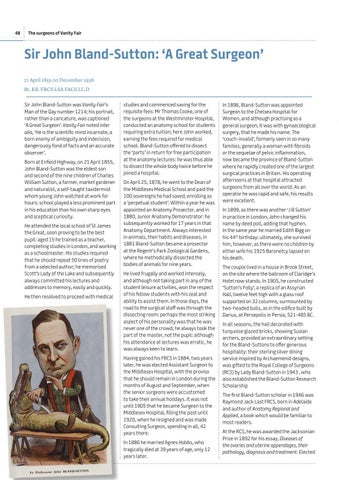48
The surgeons of Vanity Fair
Sir John Bland-Sutton: ‘A Great Surgeon’ 21 April 1855-20 December 1936 Bt. KB. FRCS LSA FACS LL.D Sir John Bland-Sutton was Vanity Fair’s Man of the Day number 1214; his portrait, rather than a caricature, was captioned ‘A Great Surgeon’. Vanity Fair noted inter alia, ‘He is the scientific mind incarnate, a born enemy of ambiguity and indecision, dangerously fond of facts and an accurate observer’. Born at Enfield Highway, on 21 April 1855, John Bland-Sutton was the eldest son and second of the nine children of Charles William Sutton, a farmer, market gardener and naturalist, a self-taught taxidermist whom young John watched at work for hours: school played a less prominent part in his education than his own sharp eyes and sceptical curiosity. He attended the local school of St James the Great, soon proving to be the best pupil: aged 15 he trained as a teacher, completing studies in London, and working as a schoolmaster. His studies required that he should repeat 50 lines of poetry from a selected author; he memorised Scott’s Lady of the Lake and subsequently always committed his lectures and addresses to memory, easily and quickly. He then resolved to proceed with medical
studies and commenced saving for the requisite fees: Mr Thomas Cooke, one of the surgeons at the Westminster Hospital, conducted an anatomy school for students requiring extra tuition; here John worked, earning the fees required for medical school. Bland-Sutton offered to dissect the ‘parts’ in return for free participation at the anatomy lectures: he was thus able to dissect the whole body twice before he joined a hospital. On April 25, 1878, he went to the Dean of the Middlesex Medical School and paid the 100 sovereigns he had saved, enrolling as a ‘perpetual student’. Within a year he was appointed an Anatomy Prosector, and in 1880, Junior Anatomy Demonstrator: he subsequently worked for 17 years in that Anatomy Department. Always interested in animals, their habits and diseases, in 1881 Bland-Sutton became a prosector at the Regent’s Park Zoological Gardens, where he methodically dissected the bodies of animals for nine years. He lived frugally and worked intensely, and although not taking part in any of the student leisure activities, won the respect of his fellow students with his zeal and ability to assist them. In those days, the road to the surgical staff was through the dissecting room: perhaps the most striking aspect of his personality was that he was never one of the crowd, he always took the part of the master, not the pupil: although his attendance at lectures was erratic, he was always keen to learn. Having gained his FRCS in 1884, two years later, he was elected Assistant Surgeon to the Middlesex Hospital, with the proviso that he should remain in London during the months of August and September, when the senior surgeons were accustomed to take their annual holidays. It was not until 1905 that he became Surgeon to the Middlesex Hospital, filling the post until 1920, when he resigned and was made Consulting Surgeon, spending in all, 42 years there. In 1886 he married Agnes Hobbs, who tragically died at 39 years of age, only 12 years later.
In 1896, Bland-Sutton was appointed Surgeon to the Chelsea Hospital for Women, and although practising as a general surgeon, it was with gynaecological surgery, that he made his name. The ‘couch-invalid’, formerly seen in so many families, generally a woman with fibroids or the sequelae of pelvic inflammation, now became the province of Bland-Sutton where he rapidly created one of the largest surgical practices in Britain. His operating afternoons at that hospital attracted surgeons from all over the world. As an operator he was rapid and safe, his results were excellent. In 1899, as there was another ‘J B Sutton’ in practice in London, John changed his name by deed poll, adding that hyphen. In the same year he married Edith Bigg on his 44th birthday: ultimately, she survived him, however, as there were no children by either wife his 1925 Baronetcy lapsed on his death. The couple lived in a house in Brook Street, on the site where the ballroom of Claridge’s Hotel now stands. In 1905, he constructed ‘Sutton’s Folly’, a replica of an Assyrian Hall, twelve feet high with a glass roof supported on 32 columns, surmounted by two-headed bulls, as in the edifice built by Darius, at Persepolis in Persia, 521-485 BC. In all seasons, the hall decorated with turquoise glazed bricks, showing Susian archers, provided an extraordinary setting for the Bland-Suttons to offer generous hospitality: their sterling silver dining service inspired by Archaemenid designs, was gifted to the Royal College of Surgeons (RCS) by Lady Bland-Sutton in 1943 , who also established the Bland-Sutton Research Scholarship The first Bland-Sutton scholar in 1946 was Raymond Jack Last FRCS, born in Adelaide and author of Anatomy Regional and Applied, a book which would be familiar to most readers. At the RCS, he was awarded the Jacksonian Prize in 1892 for his essay, Diseases of the ovaries and uterine appendages, their pathology, diagnosis and treatment. Elected
